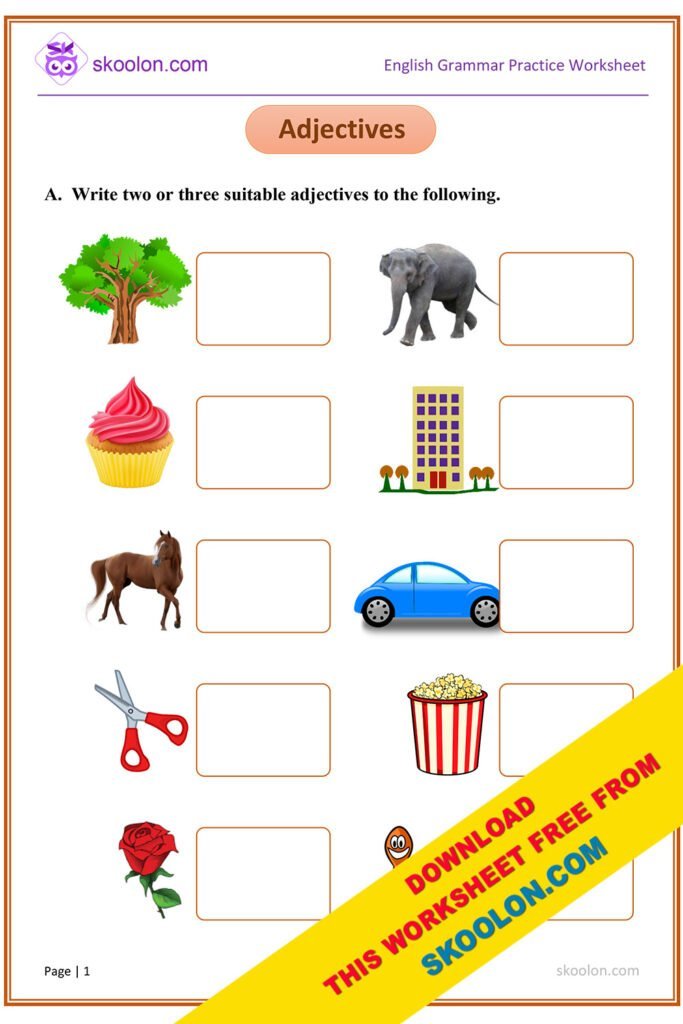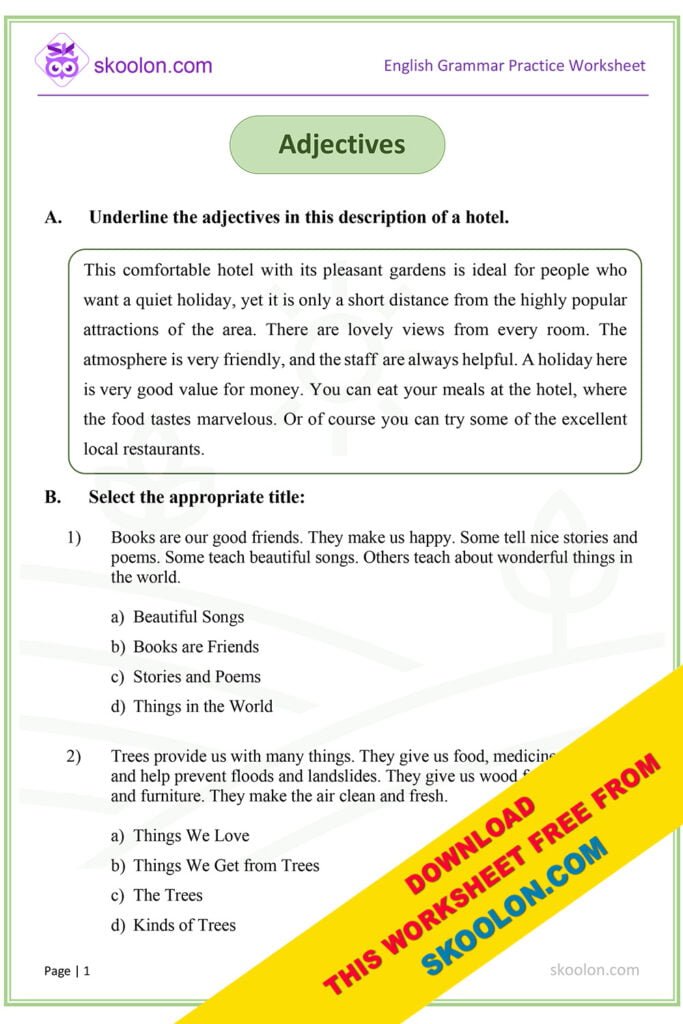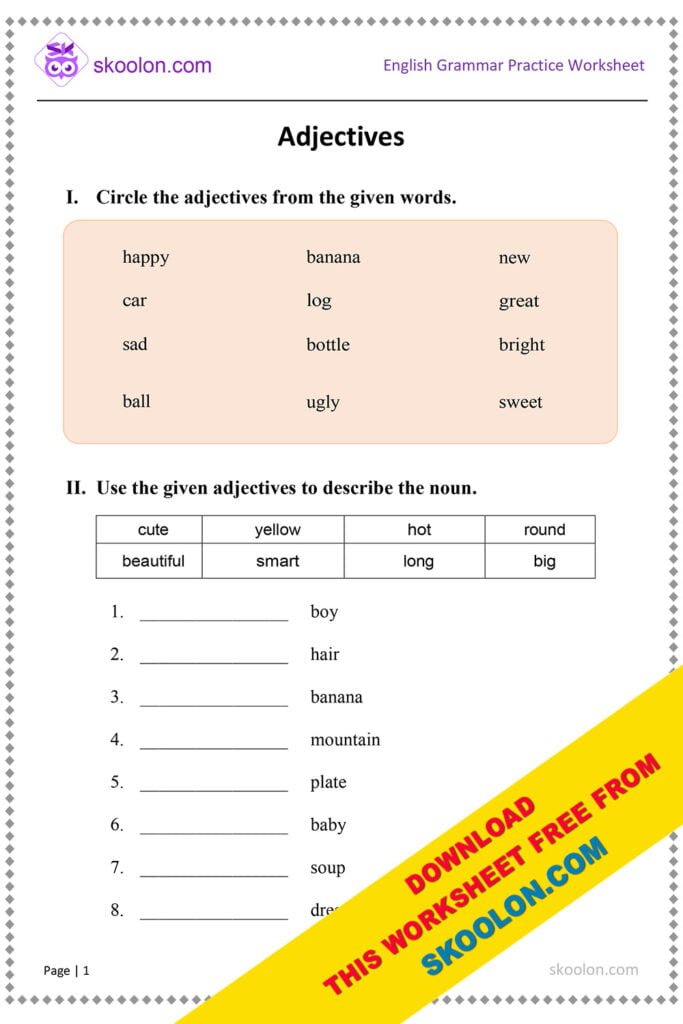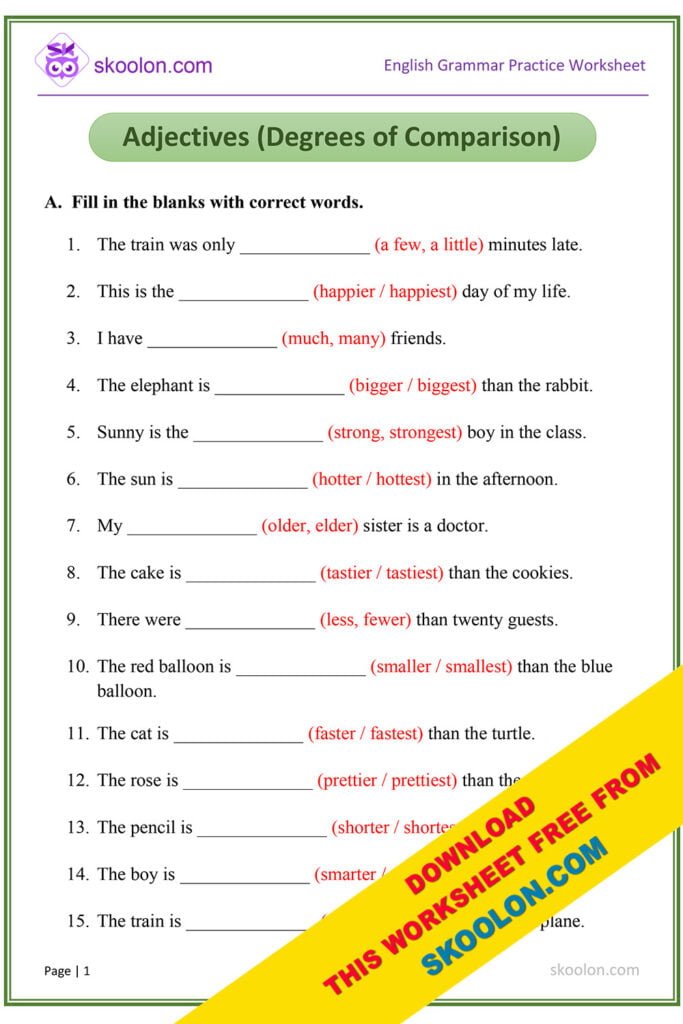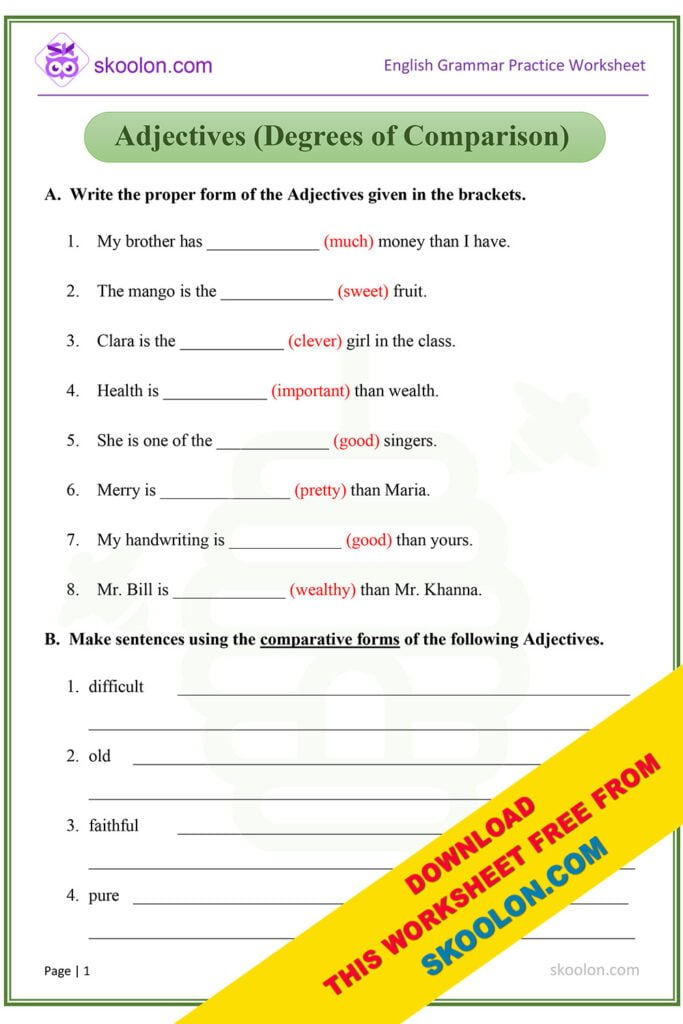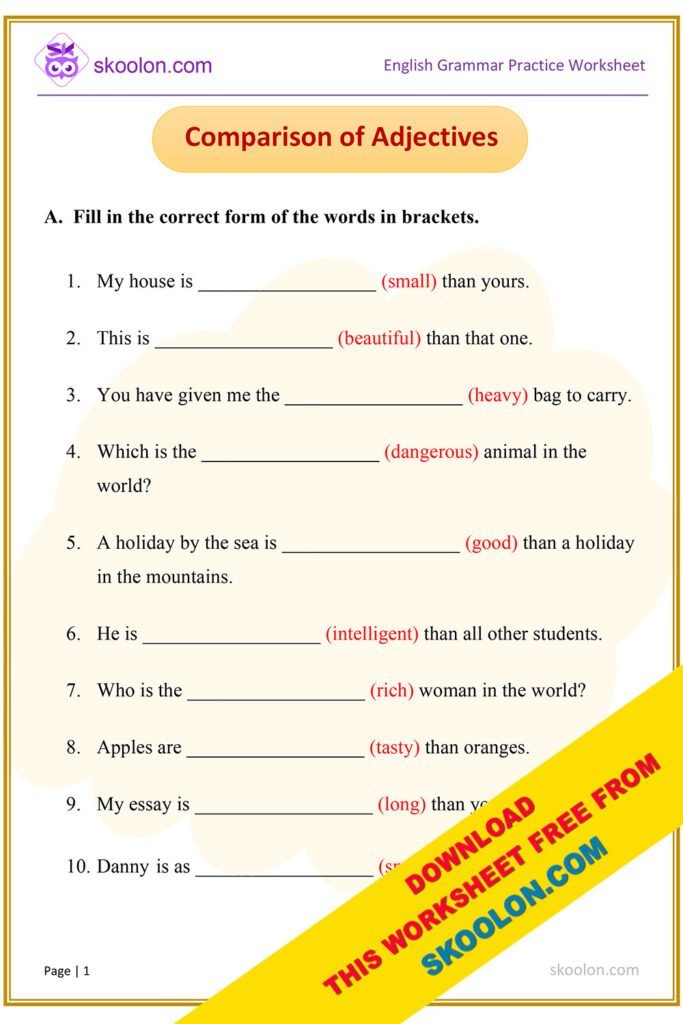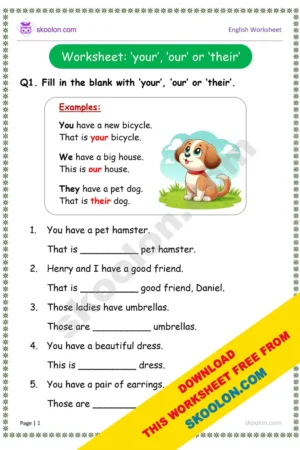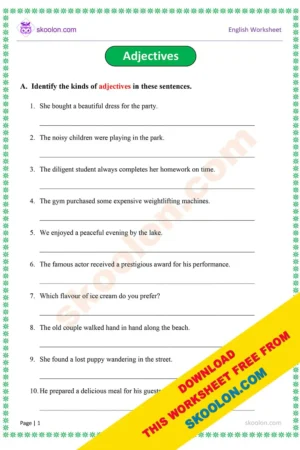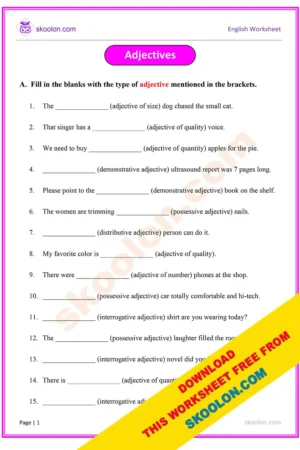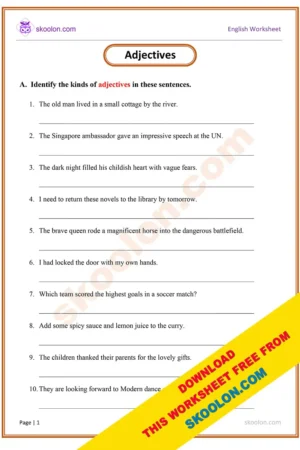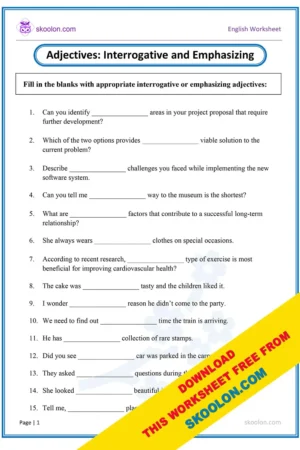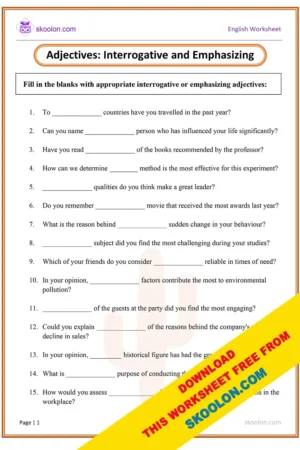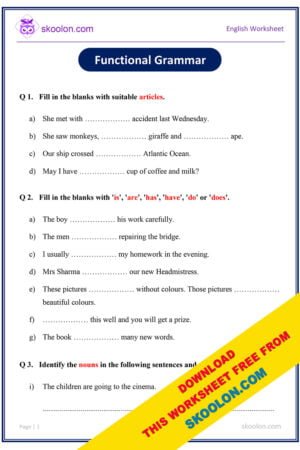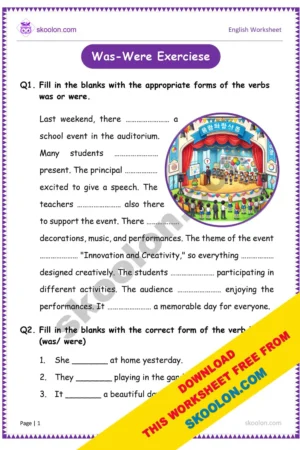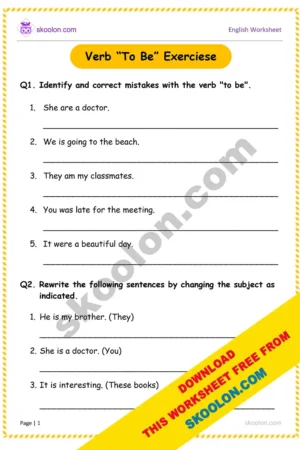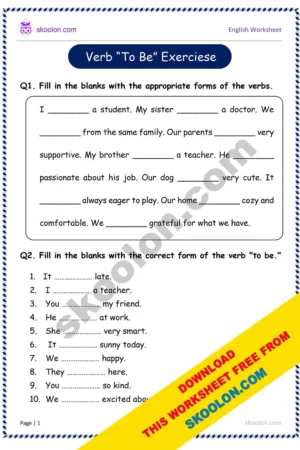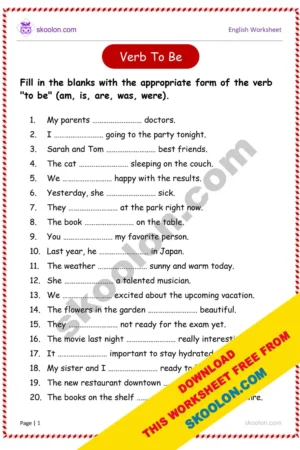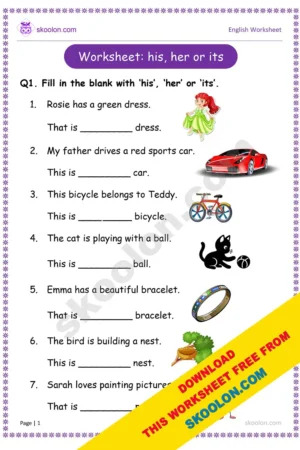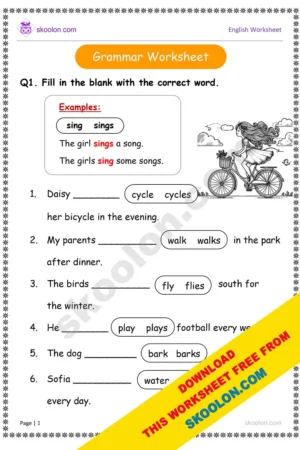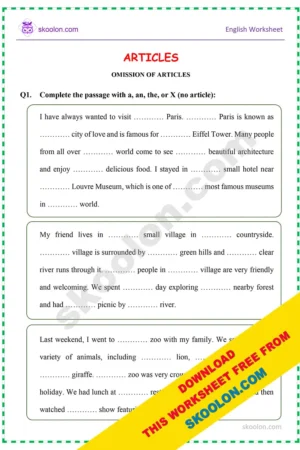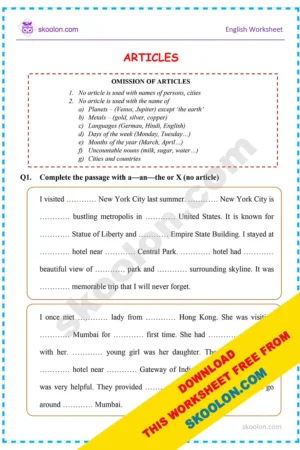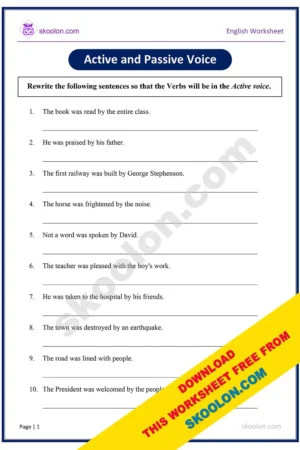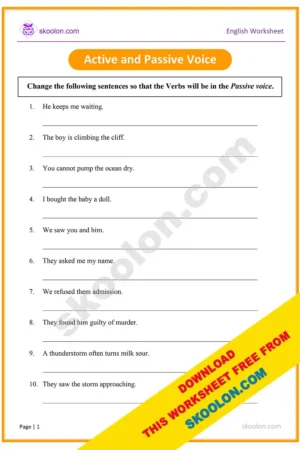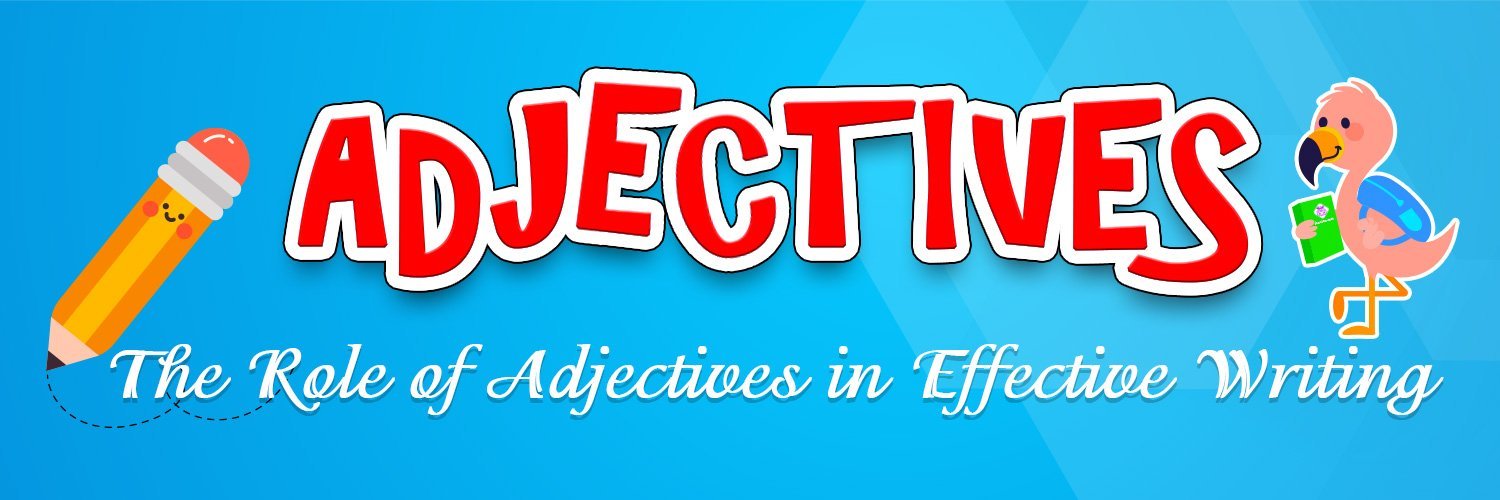
Adjectives: A Complete Guide to Enhancing Your Writing
Adjectives play a crucial role in effective writing by adding detail, depth, and emotion to our descriptions. By carefully choosing and using the right adjectives, writers can paint vivid pictures in the minds of their readers and create a more engaging and memorable reading experience. Adjectives can be used to create a mood or tone, to establish character traits, or to convey a sense of time and place. They can also be used to clarify meaning, add emphasis, or highlight important details.
Are you struggling with adjectives in English? Do you want to improve your grammar skills and learn how to identify adjectives with ease? In this article ‘Adjectives: A complete guide to enhancing your writing’, we’ll cover everything you need to know about adjectives, including their definition, types of adjectives, their placement, and order, comparative and superlative adjectives, and provide with worksheets for practice.
What are Adjectives?
Adjectives are words that describe or modify nouns or pronouns. Adjectives add detail and description to our sentences, making them more interesting and informative. Adjectives can help us paint a picture in our minds and convey emotions and feelings.
Examples of Adjectives:
Blue, Soft, Happy, Tall, Angry, Quick
Definition of Adjectives
Adjectives are describing words. A word used with a noun to describe or point out the person, animal, place or thing which the noun names, or the tell the number or quantity, is called an Adjective.
Examples of Adjectives:
We ate sweet mango. (Mango of what kind?)
Amar is a good boy. (Boy of what kind?)
I have ten fingers. (Fingers how many?)
There is little time for preparation. (How much time?)
Three girls were lost in the jungle. (Girls how many?)
He caught a big fish. (Fish of what kind?)
In the sentences sweet, good, ten, little, three and big all tell us about the nouns mango, boy, fingers, time, girls and fish. These words are called Adjectives.
Adjectives are usually placed before the nouns they describe, but sometimes they may be placed after the nouns as well or in a separate clause.
For example, “The tall man walked down the street” uses the adjective “tall” before the noun “man,” while “The man who was tall walked down the street” uses the adjective in a separate clause.
Types of Adjectives
There are six types or kinds of adjectives in English grammar that students need to be familiar with in order to use them effectively in their writing and speech.
- Descriptive Adjectives
- Quantitative Adjectives
- Adjectives of Number
- Demonstrative Adjectives
- Possessive Adjectives
- Interrogative Adjectives
1. Descriptive Adjectives
Descriptive adjectives or adjectives of quality are used to describe the qualities of a noun or pronoun. They answer the questions, “What kind?” “How many?” or “Which one?”
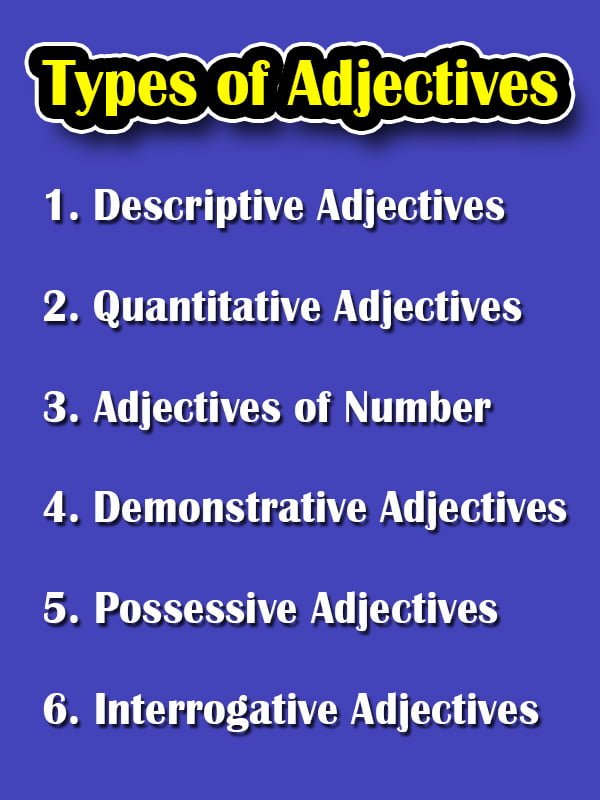
Examples of Descriptive Adjectives:
I saw a girl with curly hair.
He is an honest man.
In the above sentences curly and honest describe the quality of the hair and man. The quality means kind or sort.
Adjectives of Quality answer the question: Of what kind?
2. Quantitative Adjectives
Quantitative adjectives or adjectives of quantity are used to describe the quantity or amount of a noun. They answer the questions, “How much?” or “How many?” Examples include: “few,” “many,” “some,” “several,” etc.
Examples of Quantitative Adjectives:
Many soft drinks were wasted.
We have had enough exercises.
In the above sentences ‘many’, ‘enough’ tell us about the quantity of the things. They are called Adjectives of Quantity.
Adjectives of Quantity answer the question: How much?
3. Adjectives of Numbers
Adjectives of numbers (or Numeral adjectives) show us how many persons or things are or in what order any of them stands.
Examples of Adjectives of Numbers:
Most boys like soccer.
There are no pictures in this book.
Many men were present in the party.
In the above sentences ‘most’, ‘no’, ‘many’ answers the question: How many?
4. Demonstrative Adjectives
Demonstrative adjectives are used to point out specific nouns. They answer the questions, “Which one?” Examples include: “this,” “that,” “these,” “those,” etc.
Examples of Demonstrative Adjectives:
This boy is stronger than John.
I hate such men.
In the above sentences ‘this’, ‘such’ answers the question: which one?
5. Possessive Adjectives
Possessive adjectives are used to show ownership, possession or belonging of a noun. They answer the question, “Whose?” Examples include: “my,” “your,” “his,” “her,” “its,” “our,” “their,” etc.
Examples of Possessive Adjectives:
This is my car.
Your friends gave me this book.
In the above sentences ‘my’, ‘your’ answers the question: whose?
6. Interrogative Adjectives
Interrogative adjectives are used to ask questions about a noun. They are often followed by a noun or noun phrase. Examples include: “which,” “what,” “whose,” etc.
Examples of Possessive Adjectives:
Which way shall we go?
What colour are your dress?
Whose slippers are these?
Adjectives Worksheets for Primary Classes
Adjectives in English Grammar
(1) Placement of Adjectives
Adjectives are words that describe or modify nouns. Usually, adjectives come before the noun they describe, like “big house” or “red car.” However, there are times when the adjective comes after the noun, like when describing a quality, such as “The car is new,” or when using adjectives for emphasis, like “The book is amazing!”
Compound adjectives, on the other hand, consist of a number of words that describe a noun together. These usually come before the noun, like “bright red car” or “black leather coat.” However, there are times when the order can change, depending on what you want to emphasize. For example, “leather black coat” emphasizes that the jacket is made of leather, and also happens to be black.
Examples of some exceptions in different type of adjectives:
Adjectives of quality: Some adjectives that describe the quality of a noun come after the noun. For example, “The car is new.” In this sentence, “new” is describing the quality of the car and comes after the noun.
Adjectives of quantity: Adjectives of quantity, such as “few,” “several,” and “many,” can come before or after the noun. For example, “few people” or “people few.”
Compound adjectives: Compound adjectives are made up of two or more words that function as a single adjective. They usually come before the noun they describe, but sometimes they can come after. For example, “The car is bright blue” or “The blue car is bright.”
Adjectives used for emphasis: Adjectives used for emphasis can come before or after the noun. For example, “The best book” or “The book is best.”
Adjectives used in exclamations: Adjectives used in exclamations, such as “fantastic!” or “amazing!” can come before or after the noun. For example, “fantastic book!” or “book fantastic!”
It is generally true that adjectives come before nouns in English, but there are exceptions to this rule. It depends on the intended meaning of the sentence which adjectives should come before or after the noun. For example, quality adjectives, quantity adjectives, compound adjectives, emphasis adjectives, or exclamatory adjectives should come before or after the noun.
(2) Order of Adjectives
The order of adjectives is important to ensure that the sentence makes sense and is grammatically correct. For example, “the big, brown, fluffy dog” makes sense because the adjectives are in the correct order. If we were to say, “the fluffy, brown, big dog,” it would sound awkward and incorrect.
When using multiple adjectives to describe a noun, there is a specific order in which they should be placed in English grammar. This order is known as the order of adjectives, and it is based on the function that each adjective performs in describing the noun.
The order of adjectives is as follows:
Determiners – articles (a, an, the), possessives (my, his, her, their), and other words that indicate quantity or specificity (several, few, each, every)
Observation or opinion – adjectives that describe a general opinion or observation about the noun (beautiful, delicious, amazing)
Size – adjectives that describe the size of the noun (big, small, tall)
Shape – adjectives that describe the shape of the noun (round, square, oval)
Age – adjectives that describe the age of the noun (old, young, new)
Color – adjectives that describe the color of the noun (red, blue, green)
Origin – adjectives that describe the origin or source of the noun (French, Chinese, American)
Material – adjectives that describe the material of which the noun is made (wooden, metal, plastic)
Purpose or qualifier – adjectives that describe the purpose or function of the noun (cooking, swimming, sleeping)
For example, in the phrase “a beautiful big round Italian pizza,” the adjectives are ordered according to this rule: determiner (a), observation (beautiful), size (big), shape (round), origin (Italian), and type (pizza).
Depending on the context and the specific adjectives being used, not all of these categories need to be included in every description of a noun. It is possible to create more natural-sounding and grammatically correct sentences by following this general order of adjectives.
(3) Adjectives: Degrees of Comparison
Adjectives have different degrees of comparison, which allow us to make comparisons between different qualities.
There are three degrees of comparison for adjectives in English: positive, comparative, and superlative. Each degree of comparison has its own purpose, and it is important to understand how they work in order to use them correctly.
Positive Degree
The positive degree is the most basic form of an adjective. It is used to describe a noun without comparing it to anything else. For example, “the cat is cute” uses the positive degree of the adjective “cute” to describe the cat without comparing it to any other cats.
Comparative Degree
The comparative degree is used when comparing two things or people. It is formed by adding “-er” to the end of a one-syllable adjective or by adding “more” before the adjective for longer adjectives. For example, “the cat is cuter than the dog” uses the comparative degree of the adjective “cute” to compare the cat to the dog.
Superlative Degree
The superlative degree is used when comparing three or more things or people. It is formed by adding “-est” to the end of a one-syllable adjective or by adding “most” before the adjective for longer adjectives. For example, “the cat is the cutest animal in the shelter” uses the superlative degree of the adjective “cute” to describe the cat as the most cute animal in the shelter.
Roma is a sweet girl.
Jenny is sweeter than Roma.
Monica is the sweetest of the three.
In the above sentences Adjectives change the form (sweet, sweeter, sweetest) to show comparison. They are called the three Degrees of Comparison.
The Adjective sweet is said to be in the Positive Degree.
The Adjective sweeter is said to be in the Comparative Degree.
The Adjective sweetest is said to be in the Superlative Degree.
Irregular Adjectives
Some adjectives have irregular comparative and superlative forms. For example, “good” has the comparative form “better” and the superlative form “best.”
Adjectives Degrees of Comparison Worksheets
Formation of Comparatives and Superlatives
1.
Some Adjectives form their comparatives by adding -er and the Superlative by adding -est to the positive.
Positive | Comparative | Superlative |
sweet | sweeter | sweetest |
bold | bolder | boldest |
long | longer | longest |
tall | taller | tallest |
clever | cleverer | cleverest |
deep | deeper | deepest |
kind | kinder | kindest |
high | higher | highest |
small | smaller | smallest |
young | younger | youngest |
great | greater | greatest |
thick | thicker | thickest |
poor | poorer | poorest |
2.
If the Positive ends in -e, then -r and -st are added to form to Comparative and Superlative.
Positive | Comparative | Superlative |
brave | braver | bravest |
able | abler | ablest |
white | whiter | whitest |
fine | finer | finest |
noble | nobler | noblest |
large | larger | largest |
wise | wiser | wisest |
3.
When the Positive ends in y, preceded by a consonant, the y is changed into i before adding er and est. But if the y has a vowel before it, it is not changed into i.
Positive | Comparative | Superlative |
easy | easier | easiest |
happy | happier | happiest |
heavy | heavier | heaviest |
merry | merrier | merriest |
wealthy | wealthier | wealthiest |
healthy | healthier | healthiest |
4.
By adding er or est to the positive when it ends in -y with a vowel before it
Positive | Comparative | Superlative |
grey | greyer | greyest |
gay | gayer | gayest |
easy | easier | easiest |
lazy | lazier | laziest |
lovely | lovelier | loveliest |
pretty | prettier | prettiest |
5.
When the Positive ends in a single consonant, preceded by a short vowel, the consonant is doubled before adding er and est.
Positive | Comparative | Superlative |
fat | fatter | fattest |
red | redder | reddest |
big | bigger | biggest |
hot | hotter | hottest |
sad | sadder | saddest |
thin | thinner | thinnest |
6.
Some adjectives form their comparative and superlative by adding more and most before them.
Positive | Comparative | Superlative |
beautiful | more beautiful | most beautiful |
difficult | more difficult | most difficult |
cheerful | more cheerful | most cheerful |
honest | more honest | most honest |
learned | more learned | most learned |
industrious | more industrious | most industrious |
courageous | more courageous | most courageous |
wonderful | more wonderful | most wonderful |
faithful | more faithful | most faithful |
7.
Some adjectives are compared irregularly, that Comparative and Superlative are not formed from the Positive.
Positive | Comparative | Superlative |
good | better | best |
bad | worse | worst |
late | later | latest |
little | less | least |
far | farther | farthest |
far | further | furthest |
much | more | most |
little | less | least |
many | more | most |
old | older | oldest |
near | nearer | nearest |
up | upper | uppermost |
out | outer | outermost |
old | elder | eldest |
How to Use Adjectives Effectively
Using adjectives effectively can enhance your writing and make it more descriptive and engaging. Here are some tips to help you use adjectives effectively:
Be Specific
When using adjectives, be as specific as possible. For example, instead of using the word “big,” use words like “enormous,” “gigantic,” or “massive” to provide more specific and vivid details. Similarly, instead of saying “a nice car,” try using “a sleek, luxurious car” or “a vintage sports car.”
Use Active Verbs
Use active verbs in conjunction with adjectives to create more vivid and engaging writing. For example, instead of writing “the car was fast,” write “the car zoomed down the highway” or “the car raced past me.” This not only provides a more vivid description, but it also adds more action and movement to your writing.
Avoid Overusing Adjectives
Overusing adjectives can make your writing appear cluttered and overdone. Use adjectives sparingly and only when they add value to your writing. Instead of using multiple adjectives to describe something, choose one or two that best capture the essence of what you’re trying to convey.
Consider the Tone of Your Writing
The tone of your writing should dictate the types of adjectives you use. If you’re writing a serious or academic piece, you may want to use more formal adjectives like “distinguished” or “prestigious.” If you’re writing something more lighthearted, you can use more playful adjectives like “quirky” or “whimsical.”
Use Adjectives to Create Vivid Imagery
One of the main functions of adjectives is to create vivid imagery in your writing. For example, instead of saying “the house was old,” try using “the creaky, century-old house.” This not only provides more information but also creates a more vivid and memorable image in the reader’s mind.
Common Mistakes to Avoid When Using Adjectives
While adjectives can enhance your writing and provide vivid descriptions, there are some common mistakes that writers make when using them. Here are some mistakes to avoid when using adjectives:
Using Too Many Adjectives
One common mistake is using too many adjectives in one sentence. This can make your writing appear cluttered and overdone. Instead, choose one or two adjectives that best capture the essence of what you’re trying to convey.
Using Vague Adjectives
Another mistake is using vague adjectives that don’t provide specific information or add value to your writing. For example, using words like “nice” or “good” doesn’t provide enough detail for the reader to visualize what you’re describing. Instead, use more specific adjectives that paint a clearer picture.
Using Clichéd Adjectives
Clichéd adjectives like “beautiful,” “amazing,” or “awesome” are overused and don’t add much value to your writing. Instead, use more unique and specific adjectives that provide a more detailed and interesting description.
Using Adjectives Instead of Strong Verbs
While adjectives can add descriptive details to your writing, they shouldn’t be used as a substitute for strong verbs. Instead of using multiple adjectives to describe an action, use a strong verb that conveys the same meaning in a more concise and powerful way.
Using Adjectives to State the Obvious
Using adjectives to state the obvious can make your writing appear redundant and unnecessary. For example, saying “the blue sky” is stating the obvious, as the sky is commonly associated with the color blue. Instead, use adjectives that provide unique and interesting details.
By avoiding these common mistakes and using adjectives effectively, you can enhance your writing and provide more vivid descriptions that engage and captivate your readers.
Examples of Effective Adjective Usage
Using adjectives effectively can greatly enhance your writing and make it more engaging for readers. Here are some examples of effective adjective usage:
Vivid Descriptions
Adjectives can help you create vivid descriptions that paint a clear picture in the reader’s mind. For example, instead of saying “the car drove down the road,” you could say “the sleek, silver sports car sped down the winding, tree-lined road.” This description provides much more detail and helps the reader visualize the scene.
Emotionally Charged Language
Adjectives can also be used to create emotionally charged language that resonates with readers. For example, instead of saying “the baby cried,” you could say “the tiny, helpless baby wailed inconsolably.” This description creates a stronger emotional connection with the reader.
Unique and Specific Details
Adjectives can also be used to provide unique and specific details that make your writing more interesting and engaging. For example, instead of saying “the house was old,” you could say “the dilapidated, Victorian-era house had creaky floorboards and peeling wallpaper.” This description provides more unique and interesting details that capture the reader’s attention.
Creating Tone
Adjectives can also be used to create tone and set the mood for your writing. For example, using adjectives like “haunting,” “mysterious,” or “eerie” can create a spooky or unsettling tone, while adjectives like “joyful,” “whimsical,” or “uplifting” can create a happy and positive tone.
By using adjectives effectively and thoughtfully, you can create more engaging and powerful writing that resonates with your readers.
Adjectives Worksheets for Practice
Your Our Their Worksheet
Fill in the blank with ‘your’, ‘our’ or ‘their’.
Adjectives-16
Fill in the blanks with the type of adjective.
Adjectives-15
Identify the kinds of adjectives in these sentences.
Adjectives-14
Fill in the blanks with the type of adjective.
Adjectives-13
Identify the kinds of adjectives in these sentences.
Adjectives – Interrogative and Emphasizing-2
Fill in the blanks with appropriate interrogative or emphasizing adjectives.
Adjectives – Interrogative and Emphasizing
Fill in the blanks with appropriate interrogative or emphasizing adjectives.
Describing Words Worksheet
Describing Words / Adjectives worksheet with Answers. Check the Answers in the Description.
Functional Grammar Worksheet
Fill in the blanks with suitable articles. check more question…
Basic English Grammar Worksheets
Adjectives are just one part of English grammar, and there are many different aspects of English grammar that students need to learn. That’s why there are many basic English grammar worksheets available online that cover various topics such as nouns, verbs, adverbs, prepositions, and more.
Was Were Worksheet-4
Fill in the blanks with a suitable verb was or were.
Was Were Worksheet-3
Fill in the blanks with a suitable verb was or were.
Verb to be Worksheet-5
Identify and correct mistakes with the verb “to be”.
Verb to be Worksheet-4
Fill in the blank with the correct verb to be.
Verb to be Worksheet-3
Fill in the blank with the correct verb to be.
Your Our Their Worksheet
Fill in the blank with ‘your’, ‘our’ or ‘their’.
His Her Its Worksheet-1
Fill in the blank with ‘his’, ‘her’ or ‘its’.
Grammar for Kids – Correct Word Worksheet
Fill in the blank with the correct word.
Articles a an the or zero article exercises-2
Complete the passage with a—an—the or X (no article)
Articles a an the or zero article exercises-1
Complete the passage with a—an—the or X (no article)
Active Passive Voice Exercise-7
Active Passive Voice Exercises with answers.
Active Passive Voice Exercise-6
Active Passive Voice Exercises with answers.

